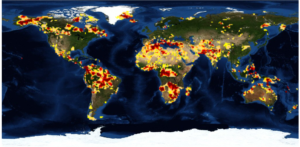by Daniel Brouse
EARTH — The world is experiencing one of the worst years of drought ever recorded. The conditions are so bad in India that the state of Bihar has banned daytime cooking. “We call this the fire season in Bihar,” a state-disaster management official said. “Strong, westerly winds stoke fires which spread easily and cause great damage.” So far, the fires have killed 79 people. Over 300 people have died of heat-related illness in the past month. There are armed guards stationed at India’s dams. Al Jazeera reports, “Trains loaded with water are being moved across the country, but farmers’ wells are drying up and drinking water is being rationed. Arriving almost daily, each train brings millions of litres of water to this drought-stricken area. But even this is not enough.”
India is not alone. Africa is also facing severe droughts. SABC News of South Africa reports, “Residents of three major Free State towns – Kroonstad, Steynsrus Viljoenskroon and Bloemfontein – are being slapped with even tighter water restrictions as the area’s main water source is fast running dry. Residents are complaining that the situation is so bad that they cannot use lavatories and that business has been affected. Taps are expected to run empty within a month as the dam is nearing empty level.”
Operation USA released a statement saying, “East Africa is currently experiencing the worst drought to hit the region in 60 years. The UN has officially declared famine in parts of southern Somalia—regions of Lower Shabelle and southern Bakool. It is predicted that the entire south of Somalia will face famine within the next two months. Operation USA is working to assess unmet needs on the ground, with its initial response focusing on water resource needs in Kenya’s Dadaab refugee camps. The Dadaab camps–the largest in the world–are reported to receive as many as 1,300 refugees a day, the majority fleeing war-torn Somalia. These camps house almost 400,000 displaced people in three camps originally designated for 90,000.
Other countries in the Horn of Africa are being severely affected by drought. Successive seasons of failed rains—combined with increasing food prices, conflict and limited humanitarian access—have resulted in food and water shortages, acute malnutrition and mass displacement throughout the region. The lack of rain has also contributed to massive livestock deaths undermining the livelihoods of those who depend on them for economic and food security. Estimates are that there are at least 1.5 million displaced people—and 10 million people in need of immediate food assistance as a result of this crisis.”
China has been impacted by drought, as well. CCTV News states, “Southern China is facing the worst drought in a century. By March 16th, nearly 6.5 million hectares of farmland had been affected, and more than 20 million people faced drinking water shortages.”
Closer to home, the U.S. is facing the longterm consequences of drought. US News and World Report states, ‘”The Gold Rush State has sunk more than 45 feet since 1935 – something the U.S. government calls the “largest human alteration of the earth’s surface.” But earthquakes aren’t the cause. It’s happening because of excessive groundwater mining brought on by drought, and geologists say all the rain in the world won’t reverse cave-ins of dirt and rock in underground aquifers. “‘
“We’ve not seen anything like this in recent history,” says University of California professor Jay Lund. “The last time we saw this was in the ’20s and ’30s when we had the Dust Bowl.”
The government agency NIDIS (drought.gov) reports, “The global monthly high temperature record has been broken for the eleventh consecutive month. According to NOAA, March 2016 was 2.20 degree Celsius warmer than the average March temperature and was the highest departure of any month in the record which begins in January 1880. In Europe, drought conditions remain intense around the Mediterranean Sea while interior and northern Europe is wetter than last month. In Asia, drought expanded in and around the central and western Indian sub-continent, as well as intensifying in the West. In India, sugar production is expected to fall 5-7% while in Thailand, rice production is expected to rise 11% in the coming year with the easing of the drought there. In Africa, short-term drought remains strong in the North and the South and has intensified around the equator. In Somalia, 40% of the population of the North is suffering from drought and need emergency aid. In South Africa, an anticipated reduction in the 2016 fruit crop may have an impact on global shipping companies. In North America, drought remains entrenched in the higher latitudes, and is expanding in Mexico. Western US snowpack is near-average, the best conditions since 2011. In South America, drought remains in the northern part of the continent, despite some slight easing, while the South saw much-needed rain again this month. Venezuela, the capital of Caracas could soon begin to experience rolling blackouts as the Guri Dam, which supplies much of its’ power, is approaching critically low water levels. In Oceania, drought eased slightly in Southern Australia while remaining firmly entrenched in the islands to the north. Australian is anticipating a rebound in wheat, cotton, and milk production with the waning of El Nino.”
